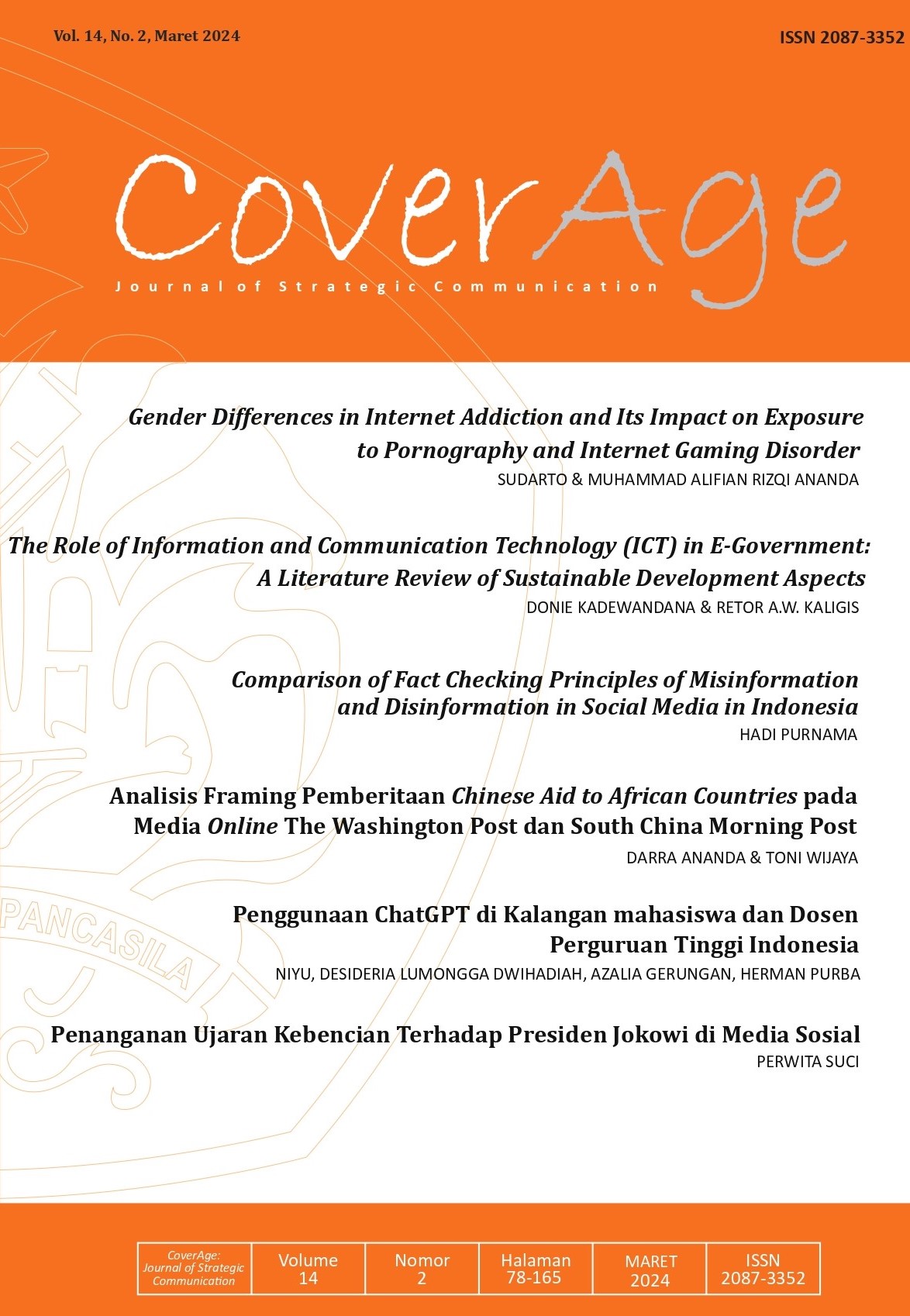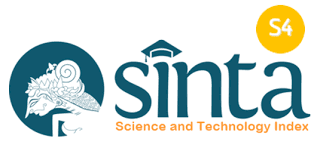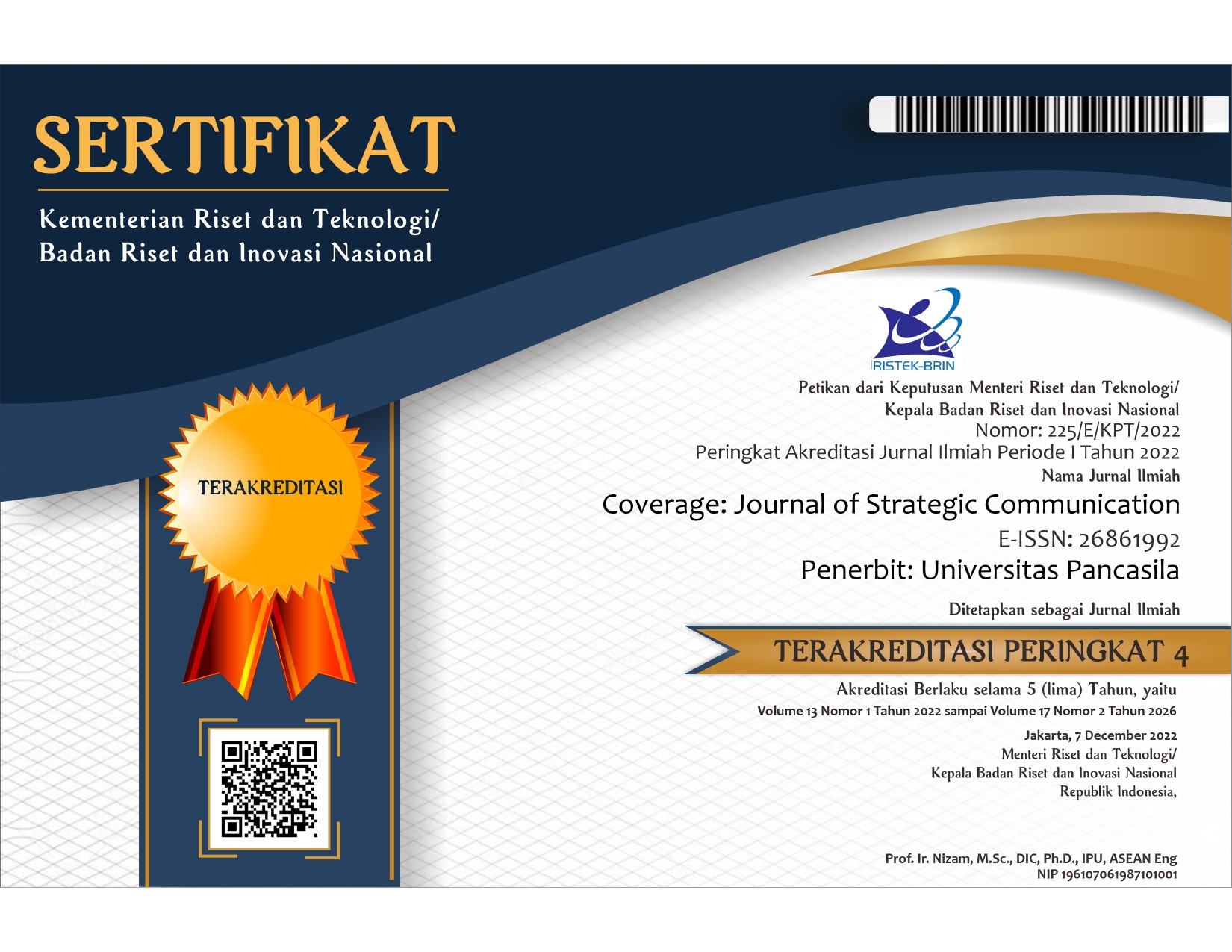Gender Differences in Internet Addiction and Its Impact on Exposure to Pornography and Internet Gaming Disorder
DOI:
https://doi.org/10.35814/coverage.v14i2.6412Keywords:
Internet Addiction, Pornography, Internet Gaming Disorder, Adolescent, Online BehaviourAbstract
Various studies have shown that internet addiction and its impact can vary by gender. Previous research has shown that excessive internet use in men is associated with addiction to video games, while in women it is linked to social media addiction. There is still little research on internet addiction that inferentially inferences its impact on gender differences. The study aims to test gender differences in internet addiction and its impact on exposure to pornography and Internet Gaming Disorder (IGD) among adolescents. The data was collected through a survey of 242 students at one of the state high schools in Jakarta. The results of the study showed no gender differences in internet addiction, but there were gender differences in terms of the impact of Internet addiction on pornography exposure and IGD. MANOVA's results showed an association between internet addictions and pornographic exposure, and IGD. Male adolescents tend to be more exposed to pornography and experience IGD compared to female adolescents. This research brings early warning about the impact of excessive internet use on future online behavioural problems. Although the impact of internet addiction on adolescents is not at its highest level, we need to be careful about this. In the future, access to the Internet is becoming easier and cheaper, plus the world's educational pressure on adolescents students is increasing, fearing that adolescents will seek escape through excessive use of the Internet.
References
Alexandraki, K., Stavropoulos, V., Burleigh, T. L., King, D. L., & Griffiths, M. D. (2018). Internet pornography viewing preference as a risk factor for adolescent Internet addiction: The moderating role of classroom personality factors. Journal of Behavioral Addictions, 7(2), 423–432. https://doi.org/10.1556/2006.7.2018.34
Andreassen, C. S., Billieux, J., Griffiths, M. D., Kuss, D. J., Demetrovics, Z., Mazzoni, E., & Pallesen, S. (2016). The relationship between addictive use of social media and video games and symptoms of psychiatric disorders: A large-scale cross-sectional study. Psychology of Addictive Behaviors, 30(2), 252.
Armando, A., & Aziz, A. (2004). Mengupas batas pornografi. Kementerian Pemberdayaan Perempuan.
Ashton, S., McDonald, K., & Kirkman, M. (2019). What does ‘pornography’mean in the digital age? Revisiting a definition for social science researchers. Porn Studies, 6(2), 144–168.
Astuti, R. (2019). Skrining Tingkat Adiksi Pornografi Siswa SMA dan SMP Tahun 2017.
Jurnal Penelitian Kebijakan Pendidikan, 11(2), 83–98. https://doi.org/10.24832/jpkp.v11i2.226
Awan, H. A., Aamir, A., Diwan, M. N., Ullah, I., Pereira-Sanchez, V., Ramalho, R., Orsolini, L., de Filippis, R., Ojeahere, M. I., Ransing, R., & others. (2021). Internet and pornography use during the COVID-19 pandemic: presumed impact and what can be done. Frontiers in Psychiatry, 12, 623508.
Cole, S. H., & Hooley, J. M. (2013). Clinical and Personality Correlates of MMO Gaming: Anxiety and Absorption in Problematic Internet Use. Social Science Computer Review, 31(4), 424–436. https://doi.org/10.1177/0894439312475280
Evren, C., Evren, B., Dalbudak, E., Topcu, M., & Kutlu, N. (2019). Relationships of Internet addiction and Internet gaming disorder symptom severities with probable attention deficit/hyperactivity disorder, aggression and negative affect among university students. ADHD Attention Deficit and Hyperactivity Disorders, 11(4), 413–421. https://doi.org/10.1007/s12402-019-00305-8
Gayatri, G., al, et, Rusadi, U., Meiningsih, S., Mahmudah, D., Sari, D., & Cahyo Nugroho, A. (2015). Digital Citizenship Safety among Children And Adolescents in Indonesia.
Gentile, D. A., Choo, H., Liau, A., Sim, T., Li, D., Fung, D., & Khoo, A. (2011). Pathological video game use among youths: A two-year longitudinal study. Pediatrics, 127(2), e319-e329.
Griffiths, M. D., Király, O., Pontes, H. M., & Demetrovics, Z. (2015). An Overview of Problematic Gaming. In Mental Health in the Digital Age (pp. 27–45). https://doi.org/10.1093/med/9780199380183.003.0002
Hassan, T., Alam, M. M., Wahab, A., & Hawlader, M. D. (2020). Prevalence and associated factors of internet addiction among young adults in Bangladesh. Journal of the Egyptian Public Health Association, 95(1), 1–8. https://doi.org/10.1186/s42506-019-0032-7
Herdiansyah, H., & Dimyati, D. (2023). Socialization Skills and Cooperative Games During The Pandemic: An Experimental Study on Students Having Slow Development of Communication. CoverAge: Journal of Strategic Communication, 13(2), 74–84. https://doi.org/10.35814/coverage.v13i2.4322
Ioannidis, K., Treder, M. S., Chamberlain, S. R., Kiraly, F., Redden, S. A., Stein, D. J., Lochner, C., & Grant, J. E. (2018). Problematic internet use as an age-related multifaceted problem: Evidence from a two-site survey. Addictive Behaviors, 81, 157–166. https://doi.org/10.1016/j.addbeh.2018.02.017
Kandell, J. J. (1998). Internet addiction on campus: The vulnerability of college students. Cyberpsychology and Behavior, 1(1), 11–17. https://doi.org/10.1089/cpb.1998.1.11
Király, O., Griffiths, M. D., Urbán, R., Farkas, J., Kökönyei, G., Elekes, Z., Tamás, D., & Demetrovics, Z. (2014). Problematic internet use and problematic online gaming are not the same: Findings from a large nationally representative adolescent sample. Cyberpsychology, Behavior, and Social Networking, 17(12), 749–754. https://doi.org/10.1089/cyber.2014.0475
Kuss, D. J. (2013). Internet gaming addiction: Current perspectives. In Psychology Research and Behavior Management, 6, 125–137. https://doi.org/10.2147/PRBM.S39476
Leung, L., & Lee, P. S. N. (2012). Impact of internet literacy, internet addiction symptoms, and internet activities on academic performance. Social Science Computer Review, 30(4), 403–418.
Longstreet, P., & Brooks, S. (2017). Life
satisfaction: A key to managing internet & social media addiction. Technology in Society, 50, 73–77. https://doi.org/10.1016/j.techsoc.2017.05.003
Lopez-Fernandez, O. (2015). How Has Internet Addiction Research Evolved Since the Advent of Internet Gaming Disorder? An Overview of Cyberaddictions from a Psychological Perspective. In Current Addiction Reports,2(3), 263–271. Springer. https://doi.org/10.1007/s40429-015-0067-6
Maisya, I. B., & Masitoh, S. (2020). Derajat Keterpaparan Konten Pornografi Pada Siswa Smp Dan Sma Di Dki Jakarta Dan Banten Indonesia. Jurnal Kesehatan Reproduksi, 10(2), 117–126. https://doi.org/10.22435/kespro.v10i2.2463
Neverkovich, S. D., Bubnova, I. S., Kosarenko, N. N., Sakhieva, R. G., Sizova, Z. M., Zakharova, V. L., & Sergeeva, M. G. (2018). Students’ internet addiction: study and prevention. Eurasia Journal of Mathematics, Science and Technology Education, 14(4), 1483–1495.
Paasonen, S. (2011). Online Pornography: Ubiquitous and Effaced. In The Handbook of Internet Studies (pp. 424–439). https://doi.org/10.1002/9781444314861.ch20
Pan, Y. C., Chiu, Y. C., & Lin, Y. H. (2020). Systematic review and meta-analysis of epidemiology of internet addiction. In Neuroscience and Biobehavioral Reviews, 118, 612–622. https://doi.org/10.1016/j.neubiorev.2020.08.013
Pontes, H. (2022). Internet Gaming Disorder Scale--Short-Form (IGDS9-SF). URL: Https://Www. Halleypontes. Com/Igds9sf [Accessed 2020-10-11], 10–11.
Rahiem, V. A., & Fitrananda, C. A. (2021). Persepsi Gamers tentang Aktivitas Microtransactions di Virtual Goods Marketplace Itemku. com. CoverAge: Journal of Strategic Communication, 11(2), 103–112.
Rakhmat, J. (2021). Psikologi Komunikasi. Bandung: PT. Remaja Rosda Karya. Online, Diakses Pada, 15.
Salicetia, F. (2015). Internet Addiction Disorder (IAD). Procedia - Social and Behavioral Sciences, 191, 1372–1376. https://doi.org/10.1016/j.sbspro.2015.04.292
Sarwono, S. W. (2011). Psikologi Remaja edisi revisi. Jakarta: Rajawali Pers.
Spilkova, J., Chomynova, P., & Csemy, L. (2017). Predictors of excessive use of social media and excessive online gaming in Czech teenagers. Journal of Behavioral Addictions, 6(4), 611–619.
Stavropoulos, V., Griffiths, M. D., Burleigh, T. L., Kuss, D. J., Doh, Y. Y., & Gomez, R. (2018). Flow on the Internet: a longitudinal study of Internet addiction symptoms during adolescence. Behaviour & Information Technology, 37(2), 159–172.
Su, W., Han, X., Yu, H., Wu, Y., & Potenza, M. N. (2020). Do men become addicted to internet gaming and women to social media? A meta-analysis examining gender-related differences in specific internet addiction. Computers in Human Behavior, 113, 106480. https://doi.org/10.1016/j.chb.2020.106480
Suhrawardi. (2022). Hubungan paparan pornografi melalui elektronik terhadap perilaku seksual remaja. Jurnal Inovasi Penelitian, 3(7), 7015–7020.
Syarifah. (2006). Kebertubuhan perempuan dalam pornografi. Yayasan Kota Kita. https://books.google.co.id/books?id=fAraAAAAMAAJ
Van Den Eijnden, R., Koning, I., Doornwaard, S., Van Gurp, F., & Ter Bogt, T. (2018). The impact of heavy and disordered use of games and social media on adolescents’ psychological, social, and school functioning. Journal of Behavioral Addictions, 7(3), 697–706.
Young, K. (2015). The Evolution of Internet Addiction Disorder (pp. 3–18). https://doi.org/10.1007/978-3-319-07242-5_1
Young, K. S. (2004). Internet addiction: A new clinical phenomenon and its consequences. American Behavioral Scientist, 48(4), 402–415.
Young, K. S. (2009). Internet addiction test. Center for On-Line Addictions.
Zattoni, F., Gül, M., Soligo, M., Morlacco, A., Motterle, G., Collavino, J., Barneschi, A. C., Moschini, M., & Moro, F. D. (2021). The impact of COVID-19 pandemic on pornography habits: a global analysis of Google Trends. International Journal of Impotence Research, 33(8), 824–831.





















